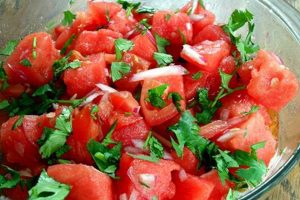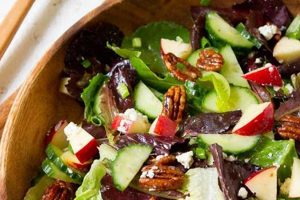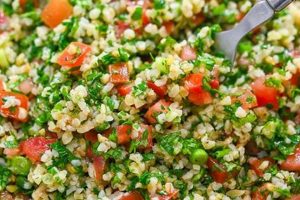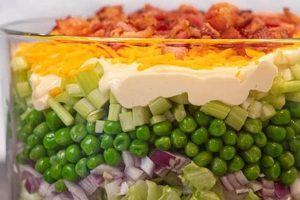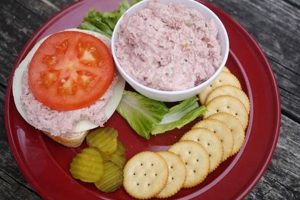Combining the tartness of cranberries with the creamy richness of cream cheese offers a flavorful profile suitable for various occasions, from holiday gatherings to everyday meals. These salads often incorporate diverse ingredients such as nuts, fruits (like oranges or apples), and vegetables (like celery), resulting in a blend of textures and tastes. A simple version might include fresh cranberries, cream cheese, orange sections, and pecans, bound together with a light dressing. More complex variations might feature whipped cream, marshmallows, or gelatin.
The appeal of such dishes lies in their balance of sweet and tart flavors, as well as the contrast between the creamy, smooth cheese and the crisp, sometimes crunchy, other components. This versatility makes them adaptable to different palates and dietary preferences. Historically, the combination of cranberries and cream cheese gained popularity as a festive side dish, particularly during the holiday season. This likely stems from the availability of fresh cranberries during autumn and winter, coinciding with holidays like Thanksgiving and Christmas.
This exploration will delve into a range of preparations, from classic to contemporary, examining the diverse ingredients and techniques that contribute to successful outcomes. It will also consider variations suitable for specific dietary needs, ensuring accessibility for a wider audience.
Tips for Cranberry Salad with Cream Cheese
Achieving optimal flavor and texture in cranberry salad with cream cheese requires attention to several key aspects of preparation.
Tip 1: Cranberry Selection: Fresh cranberries offer the brightest flavor and a pleasant tartness. However, dried cranberries (craisins) can be substituted, particularly in recipes where a chewier texture is desired. Frozen cranberries should be thawed and drained thoroughly before use.
Tip 2: Cream Cheese Consistency: Allow cream cheese to soften to room temperature for easier blending. Whipping the cream cheese before incorporating other ingredients creates a lighter, airier texture.
Tip 3: Balancing Sweetness: Adjust the amount of sugar or other sweeteners (e.g., honey, maple syrup) to achieve the desired level of sweetness, balancing the tartness of the cranberries.
Tip 4: Incorporating Nuts and Fruits: Toasted nuts add a depth of flavor and satisfying crunch. Experiment with different varieties like pecans, walnuts, or almonds. Fresh fruits such as oranges, apples, or grapes provide complementary sweetness and texture.
Tip 5: Dressing Considerations: A simple dressing of orange juice and zest enhances the flavors of the salad. Alternatively, a light vinaigrette can be used for a tangier profile. Avoid heavy dressings that might overpower the delicate flavors.
Tip 6: Chilling Time: Allow the salad to chill for at least an hour before serving. This allows the flavors to meld and the textures to settle, resulting in a more cohesive dish.
Tip 7: Presentation: Serve the salad in an attractive bowl or platter. Garnish with additional cranberries, nuts, or fresh herbs for visual appeal.
By following these tips, one can elevate a simple cranberry salad with cream cheese into a truly delightful culinary experience. The careful selection of ingredients and attention to detail in preparation ensures a balanced flavor profile and pleasing texture.
These insights provide a foundation for exploring specific recipe variations and adapting them to individual preferences.
1. Cranberry Variety (Fresh, Dried)
Cranberry variety represents a pivotal decision in crafting cranberry salad with cream cheese, significantly influencing the final dish’s texture, flavor profile, and overall aesthetic. Understanding the nuances of fresh versus dried cranberries allows for informed choices tailored to specific recipe objectives.
- Fresh Cranberries
Fresh cranberries contribute a vibrant, tart flavor and a firm, slightly juicy texture. Their bright red color enhances the salad’s visual appeal. The tartness provides a refreshing counterpoint to the richness of the cream cheese. However, their firmness requires careful balancing with other ingredients to avoid textural clashes. Recipes often incorporate methods to soften fresh cranberries, such as briefly cooking them with sugar or incorporating citrus zest.
- Dried Cranberries (Craisins)
Dried cranberries offer a chewier texture and a concentrated sweetness. They contribute a deeper, more complex flavor profile due to the dehydration process. Their softer texture readily integrates with the cream cheese, creating a smoother overall consistency. While dried cranberries can be used directly, plumping them in warm water or fruit juice before incorporating them into the salad can further enhance their texture and flavor.
- Texture Considerations
The choice between fresh and dried cranberries hinges significantly on the desired textural outcome. A salad emphasizing a crisp, refreshing experience benefits from fresh cranberries. Conversely, a salad seeking a softer, chewier texture might utilize dried cranberries. Blending both varieties can offer a nuanced textural experience.
- Flavor Dynamics
Flavor profiles differ significantly. The tartness of fresh cranberries provides a brighter, more acidic note, while the sweetness of dried cranberries offers a mellower, more concentrated flavor. These flavor nuances influence other ingredient choices, such as the type and amount of sweetener used in the recipe. Balancing these flavors is crucial for a harmonious final product.
Ultimately, the selection of cranberry variety depends on the specific flavor and texture goals of the recipe. Considering the interplay between cranberries and other ingredients, such as the cream cheese, nuts, and fruits, ensures a balanced and delicious final product. Appreciating the distinct characteristics of each cranberry type empowers informed choices that elevate cranberry salad with cream cheese from a simple dish to a culinary creation.
2. Cream Cheese Softening
Cream cheese softening plays a crucial role in the successful preparation of cranberry salad with cream cheese. The process directly impacts the texture, flavor incorporation, and overall presentation of the final dish. Unsoftened cream cheese presents challenges in achieving a smooth, evenly distributed mixture. Its firmness resists blending, resulting in a lumpy texture and uneven distribution of flavors. Conversely, softened cream cheese blends seamlessly with other ingredients, creating a homogenous mixture that showcases the complementary flavors of cranberries, nuts, and other components.
Softening allows the cream cheese to readily absorb the flavors of accompanying ingredients, creating a more cohesive and balanced flavor profile. For instance, the tartness of cranberries and the sweetness of any added sugar permeate the softened cream cheese more effectively, resulting in a harmonious blend of flavors. In contrast, using unsoftened cream cheese might lead to pockets of intense sweetness or tartness, disrupting the overall balance of the salad. The softened texture also contributes to a more appealing visual presentation. A smooth, creamy base provides an attractive backdrop for the vibrant colors of cranberries and other incorporated ingredients. Lumps of unsoftened cream cheese detract from the visual appeal, creating a less refined appearance.
Achieving optimal softening involves bringing the cream cheese to room temperature. This can be accomplished by removing it from refrigeration approximately one hour before use. Alternatively, carefully microwaving the cream cheese in short bursts can expedite the softening process. Over-softening, however, should be avoided, as it can lead to an excessively runny consistency that compromises the salad’s structure. Understanding the importance of cream cheese softening empowers informed decision-making during recipe preparation. This seemingly minor step significantly contributes to the final dish’s success, ensuring a smooth texture, balanced flavor profile, and appealing presentation.
3. Sweetener Balance
Sweetener balance represents a critical factor in cranberry salad recipes featuring cream cheese. The inherent tartness of cranberries necessitates careful calibration of sweetness to achieve a harmonious flavor profile. Insufficient sweetener allows the cranberry’s tartness to dominate, potentially creating an unpleasantly acidic experience. Excessive sweetener, conversely, masks the cranberry’s distinct character, resulting in a one-dimensional, overly sweet dish. The interplay between tartness and sweetness defines the overall gustatory experience, influencing perceptions of flavor complexity and balance. This balance hinges not only on the quantity of sweetener but also on the type employed. Granulated sugar offers a clean, straightforward sweetness, while honey or maple syrup introduce additional flavor nuances. Agave nectar, another option, provides a milder sweetness.
Consider a classic cranberry salad featuring fresh cranberries, cream cheese, orange sections, and pecans. The cranberries’ natural tartness provides a foundational flavor element. Balancing this tartness requires an appropriate amount of sweetener, typically granulated sugar, to create a pleasant contrast. The orange sections contribute a degree of sweetness and acidity, further influencing the overall balance. The inherent sweetness of pecans adds another layer to the flavor profile. Each ingredient’s contribution must be considered when determining the optimal sweetener quantity. Recipes utilizing dried cranberries, already possessing a degree of concentrated sweetness, require less added sweetener than those featuring fresh cranberries. Understanding these nuanced relationships allows for informed adjustments tailored to specific ingredient combinations and desired flavor outcomes. Modifying a recipe to accommodate dietary restrictions, such as substituting honey for granulated sugar, requires careful consideration of the honey’s distinct flavor profile and sweetness level.
Achieving sweetener balance in cranberry salad with cream cheese requires a nuanced understanding of ingredient interactions and flavor dynamics. Careful consideration of cranberry variety, additional ingredients, and sweetener type allows for precise adjustments, ensuring a harmonious final product. This balance forms the foundation for a successful recipe, transforming individual components into a unified, delectable dish. Mastery of this balance distinguishes a well-executed cranberry salad from one lacking complexity and finesse.
4. Complementary Ingredients
Complementary ingredients play a vital role in cranberry salad recipes with cream cheese, elevating the dish beyond a simple combination of core components. These additions introduce textural contrasts, enhance flavor profiles, and contribute to visual appeal. Careful selection of complementary ingredients ensures a balanced and nuanced culinary experience, transforming a basic cranberry salad into a multifaceted dish.
- Nuts
Nuts provide a crucial textural counterpoint to the creamy base of the salad. Their crunch contrasts with the smooth cream cheese and often the softer texture of the cranberries. Common choices include pecans, walnuts, and almonds, each offering distinct flavor profiles. Pecans provide a buttery richness, walnuts offer a slightly earthy note, and almonds contribute a subtle sweetness. Toasted nuts intensify these flavors, adding depth to the overall profile. The quantity of nuts influences the overall texture, with a greater quantity resulting in a more pronounced crunch.
- Fruits
Fruits introduce additional layers of flavor and texture. Oranges, with their segments of sweet-tart juice and slight bitterness from the zest, offer a classic pairing with cranberries. Apples, particularly crisp varieties like Granny Smith, provide a contrasting tartness and a firm texture. Grapes, whether green or red, contribute a juicy sweetness and a pop of color. The choice of fruit influences the overall sweetness and moisture content of the salad.
- Vegetables
Certain vegetables complement cranberry salads with cream cheese effectively. Celery, with its crisp texture and slightly vegetal flavor, offers a refreshing counterpoint to the richness of the cream cheese. Finely diced red onion introduces a subtle sharpness and a pop of color. These additions enhance the textural complexity and contribute savory notes, balancing the sweet and tart elements of the salad.
- Other additions
Beyond nuts, fruits, and vegetables, other additions can further enhance the flavor and texture profile. Dried coconut flakes offer a chewy texture and a subtle sweetness. Mini marshmallows introduce a light, airy texture and an additional element of sweetness. Candied ginger provides a spicy, pungent note and a chewy texture. These additions allow for customization, catering to individual preferences and creating unique variations on the classic cranberry salad.
The strategic incorporation of complementary ingredients elevates cranberry salad recipes with cream cheese, transforming them into complex and nuanced dishes. The interplay of textures, flavors, and colors creates a more engaging culinary experience, enhancing the overall enjoyment of the salad. Understanding the contributions of each complementary ingredient empowers informed choices, allowing for tailored flavor profiles and personalized culinary creations.
5. Chilling Duration
Chilling duration significantly influences the final quality of cranberry salad recipes incorporating cream cheese. This seemingly simple step plays a crucial role in flavor development, texture enhancement, and overall palatability. Understanding the impact of chilling time allows for informed decisions regarding preparation and serving, ensuring optimal results.
- Flavor Melding
Chilling allows the diverse flavors within the salad to meld and harmonize. The tartness of cranberries, the richness of cream cheese, the sweetness of added sugars, and the contributions of complementary ingredients like nuts and fruits integrate more fully during refrigeration. This melding creates a more cohesive and balanced flavor profile, where individual components contribute to a unified whole. A freshly prepared salad may exhibit disparate flavors, whereas a chilled salad offers a more integrated and nuanced taste experience.
- Texture Enhancement
Chilling affects the textures of various ingredients within the salad. Cream cheese firms slightly upon chilling, providing a more stable base for the other components. The chilling process also allows dried cranberries, if used, to absorb moisture from the surrounding ingredients, resulting in a plumper, more palatable texture. Fresh cranberries, while not significantly altered in texture by chilling, benefit from the overall textural harmony achieved through the chilling process.
- Temperature and Palatability
Serving temperature significantly impacts the perceived flavors and overall enjoyment of the salad. A chilled salad offers a refreshing contrast, particularly welcome during warmer months or as an accompaniment to richer dishes. The coolness enhances the perception of sweetness and tartness, creating a more vibrant flavor experience. A room-temperature or warm salad may present flavors less effectively, diminishing the overall enjoyment.
- Recommended Chilling Time
While the specific chilling time depends on the recipe and individual preferences, a general guideline recommends chilling for at least one hour before serving. This duration allows sufficient time for flavor melding and texture enhancement. For optimal results, chilling for two to four hours is often preferable, particularly for salads featuring complex flavor profiles or a variety of textural elements. Extended chilling, beyond four hours, typically offers minimal additional benefit and may, in some cases, lead to undesirable textural changes.
Chilling duration represents a crucial element in preparing cranberry salad recipes with cream cheese. The interplay of flavor melding, texture enhancement, and temperature considerations contributes significantly to the final dish’s success. Understanding these factors empowers informed choices regarding chilling time, ensuring a balanced, flavorful, and refreshing culinary experience. Proper chilling elevates this simple salad to a more refined and enjoyable dish.
Frequently Asked Questions
This section addresses common inquiries regarding cranberry salad recipes that incorporate cream cheese, offering clarity and practical guidance for successful preparation.
Question 1: Can frozen cranberries be used in these salads?
Frozen cranberries can be used, but they require thawing and thorough draining before incorporation. Excess moisture can dilute the salad’s flavor and compromise its texture. Thawing overnight in a refrigerator is recommended.
Question 2: What can be substituted for cream cheese if a lower-fat option is desired?
Lower-fat cream cheese alternatives, such as Neufchtel cheese, can be substituted. However, these alternatives may impact the final texture and flavor profile of the salad. Greek yogurt, blended until smooth, can also be considered for a tangier flavor.
Question 3: How can one prevent the salad from becoming watery?
Preventing excess moisture is crucial for maintaining optimal texture. Thoroughly draining canned fruits, using fresh cranberries judiciously, and ensuring cream cheese is not overly softened contribute to a less watery consistency.
Question 4: What are suitable alternatives to pecans or walnuts if nut allergies are a concern?
Sunflower seeds or pumpkin seeds offer comparable textural benefits and distinct flavor profiles. Alternatively, omitting nuts entirely and increasing the quantity of other complementary ingredients, such as dried fruit or chopped celery, can maintain textural interest.
Question 5: How long can cranberry salad with cream cheese be stored in the refrigerator?
Properly stored in an airtight container, the salad typically remains palatable for three to five days. However, the texture and flavor quality may diminish over time. It’s recommended to consume the salad within the first two to three days for optimal enjoyment.
Question 6: Can this salad be served as a dessert or is it strictly a side dish?
While traditionally considered a side dish, variations of cranberry salad with cream cheese can certainly function as desserts. Incorporating sweeter ingredients, such as marshmallows, whipped cream, or a richer dressing, transforms the salad into a sweeter treat. Adjusting the sweetener quantity further enhances the dessert-like profile.
Addressing these frequently asked questions provides a comprehensive understanding of cranberry salad preparation techniques and ingredient considerations, facilitating successful outcomes and culinary creativity. Applying these insights empowers individuals to create flavorful and texturally appealing cranberry salads tailored to individual preferences.
The following section will explore specific recipe variations, demonstrating the versatility and adaptability of cranberry salad with cream cheese.
Cranberry Salad Recipes with Cream Cheese
Exploration of cranberry salad recipes with cream cheese reveals a versatile dish adaptable to diverse palates and occasions. Careful consideration of cranberry variety (fresh or dried), cream cheese softening, sweetener balance, complementary ingredients (nuts, fruits, vegetables), and chilling duration contributes significantly to the final product’s success. Balancing the inherent tartness of cranberries with appropriate sweetness forms the foundation for a harmonious flavor profile. Textural contrasts, achieved through incorporating nuts or other crisp elements, enhance the overall sensory experience. Chilling allows flavors to meld and textures to settle, optimizing palatability.
The adaptability of cranberry salad recipes with cream cheese allows for continuous culinary exploration. Seasonal variations, incorporating specific fruits or spices, offer opportunities for creative expression. Dietary adaptations, such as using alternative sweeteners or lower-fat cream cheese, expand accessibility. Understanding the foundational principles of preparation empowers individuals to confidently experiment and personalize recipes, ensuring continued appreciation for this classic dish.

